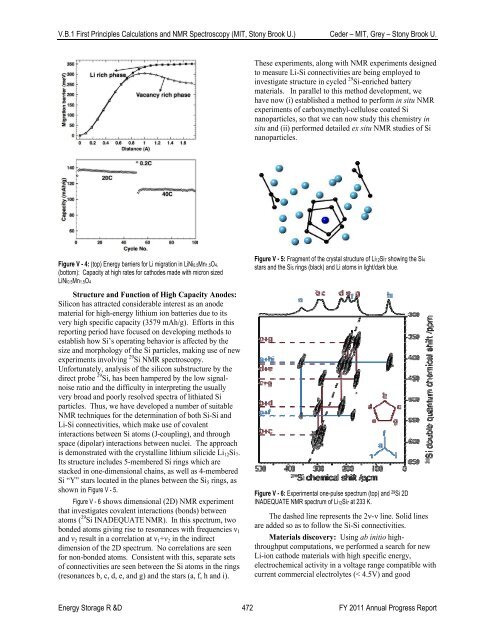V. Focused Fundamental Research - EERE - U.S. Department of ...
V. Focused Fundamental Research - EERE - U.S. Department of ...
V. Focused Fundamental Research - EERE - U.S. Department of ...
You also want an ePaper? Increase the reach of your titles
YUMPU automatically turns print PDFs into web optimized ePapers that Google loves.
V.B.1 First Principles Calculations and NMR Spectroscopy (MIT, Stony Brook U.) Ceder – MIT, Grey – Stony Brook U.<br />
These experiments, along with NMR experiments designed<br />
to measure Li-Si connectivities are being employed to<br />
investigate structure in cycled 29 Si-enriched battery<br />
materials. In parallel to this method development, we<br />
have now (i) established a method to perform in situ NMR<br />
experiments <strong>of</strong> carboxymethyl-cellulose coated Si<br />
nanoparticles, so that we can now study this chemistry in<br />
situ and (ii) performed detailed ex situ NMR studies <strong>of</strong> Si<br />
nanoparticles.<br />
Figure V - 4: (top) Energy barriers for Li migration in LiNi0.5Mn1.5O4.<br />
(bottom): Capacity at high rates for cathodes made with micron sized<br />
LiNi0.5Mn1.5O4<br />
Structure and Function <strong>of</strong> High Capacity Anodes:<br />
Silicon has attracted considerable interest as an anode<br />
material for high-energy lithium ion batteries due to its<br />
very high specific capacity (3579 mAh/g). Efforts in this<br />
reporting period have focused on developing methods to<br />
establish how Si’s operating behavior is affected by the<br />
size and morphology <strong>of</strong> the Si particles, making use <strong>of</strong> new<br />
experiments involving 29 Si NMR spectroscopy.<br />
Unfortunately, analysis <strong>of</strong> the silicon substructure by the<br />
direct probe 29 Si, has been hampered by the low signalnoise<br />
ratio and the difficulty in interpreting the usually<br />
very broad and poorly resolved spectra <strong>of</strong> lithiated Si<br />
particles. Thus, we have developed a number <strong>of</strong> suitable<br />
NMR techniques for the determination <strong>of</strong> both Si-Si and<br />
Li-Si connectivities, which make use <strong>of</strong> covalent<br />
interactions between Si atoms (J-coupling), and through<br />
space (dipolar) interactions between nuclei. The approach<br />
is demonstrated with the crystalline lithium silicide Li 12 Si 7 .<br />
Its structure includes 5-membered Si rings which are<br />
stacked in one-dimensional chains, as well as 4-membered<br />
Si “Y” stars located in the planes between the Si 5 rings, as<br />
shown in Figure V - 5.<br />
Figure V - 6 shows dimensional (2D) NMR experiment<br />
that investigates covalent interactions (bonds) between<br />
atoms ( 29 Si INADEQUATE NMR). In this spectrum, two<br />
bonded atoms giving rise to resonances with frequencies ν 1<br />
and ν 2 result in a correlation at ν 1 +ν 2 in the indirect<br />
dimension <strong>of</strong> the 2D spectrum. No correlations are seen<br />
for non-bonded atoms. Consistent with this, separate sets<br />
<strong>of</strong> connectivities are seen between the Si atoms in the rings<br />
(resonances b, c, d, e, and g) and the stars (a, f, h and i).<br />
Figure V - 5: Fragment <strong>of</strong> the crystal structure <strong>of</strong> Li12Si7 showing the Si4<br />
stars and the Si5 rings (black) and Li atoms in light/dark blue.<br />
Figure V - 6: Experimental one-pulse spectrum (top) and 29 Si 2D<br />
INADEQUATE NMR spectrum <strong>of</strong> Li12Si7 at 233 K.<br />
The dashed line represents the 2- line. Solid lines<br />
are added so as to follow the Si-Si connectivities.<br />
Materials discovery: Using ab initio highthroughput<br />
computations, we performed a search for new<br />
Li-ion cathode materials with high specific energy,<br />
electrochemical activity in a voltage range compatible with<br />
current commercial electrolytes (< 4.5V) and good<br />
Energy Storage R &D 472 FY 2011 Annual Progress Report



